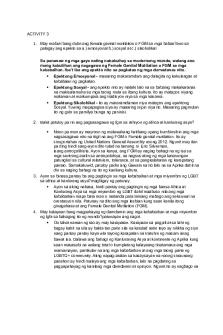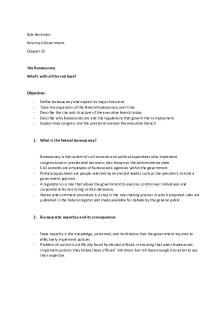American Politics - Grade: 90% PDF

| Title | American Politics - Grade: 90% |
|---|---|
| Author | Ashante Smith |
| Course | State And Local Government |
| Institution | Valencia College |
| Pages | 4 |
| File Size | 58.6 KB |
| File Type | |
| Total Downloads | 72 |
| Total Views | 163 |
Summary
Essay for POS 2112 about how we the people obtain our political information....
Description
Smith 1 POS 2112 CRN 24567 T/R Professor Rampersaud 23 January 2020 American Politics Liberals and conservatives have always disagreed on many things but there are also a lot ways that they’re alike. Some of these was involve the way that they interact with the media. For years, the citizens of the United States have received their political information through many different means. In 2016, Americans expressed their preference for receiving their news on screen. Television remains the most dominant for of screen media, with digital screens being second. However, among younger adults TV news have been dramatically low. Newspapers became to everyone’s go-to for political information during the 1800’s with a shift to radio in the early 1920’s. Eventually news channels became a popular source in America. In modern America, 95% of Americans get their news from the internet or television. Firstly, Americans obtain their political through a wide variety of sources, such as, television, social media, newspapers, the radio, and the internet. Personally, I get the majority of my political information from social media. 50% of Americans between the ages of 18-29 obtain their information through the use of the internet and 27% between through TV news. These days, people will receive more information through the use of the internet with social media and news websites than they are if they read the newspaper. Secondly, the typical person tends to remember things that are important to them and will have an effect on their society. Many times this is just the headlines. For me, if the information doesn’t really pertain to me and won’t have a direct impact on me, I tend to disregard it and will forget that I even read it. However, if it is substantial and effects my day-to-day life or my future, I am more likely to read more about it and retain it. What I hear and see or read greatly effects
Smith 2 my political views. Professor Mancur Olson created the by-product theory in which he explains that people “acquire political knowledge and opinions unintentionally rather than seeking it out. This is especially true now that we are in the age of smartphones. We are constantly receiving notifications about what is happening in different parts of the country and even those in other parts of the world. There are generally two types of news stories: hard news and soft news. Hard news generally refers to big news stories, usually just the facts. Soft news refers to stories whose main purpose is to entertain the audience, to get them interested in a topic. Some examples of hard news would be those that talk about politics, war, crime, and economics, while soft news would be considered entertainment, fashion, and lifestyle reports. Hard news is the term journalists use to refer to “news of the day.” Hard news is a chronicle of current events/incidents and is the most common news style on the front page of your typical newspaper. Hard news gives readers the information they need. Soft News is a term for news that is not necessarily time-sensitive. Soft news includes profiles of people, programs, or organizations. Feature stories take a step back from the headlines to explore an issue in depth. Knowing and understanding the difference between the two helps you to get a sense of how the news is covered and they types of news you are likely to find through the different types of sources. With understanding the two news types comes with being able to identify the different types of media sources and understanding the message that they are trying to send. This is known as media literacy. Media literacy builds an understanding of the role of media in society as well as essential skills of inquiry and self-expression necessary for citizens of a democracy. Today’s information and entertainment technologies communicate to us through a powerful combination of words, images, and sounds. As such, we need to develop a wider set of literacy skills helping
Smith 3 us to both comprehend the messages we receive and effectively utilize these tools to design and distribute our own messages. Being literate in a media age requires critical thinking skills that empower us as we make decisions. Fake news is a term that we are very often today. Fake news refers to journalism that is mostly lies. The reason for fake news is usually to tarnish the name and/or work of someone for the sole purpose of getting someone else ahead. In the age of social media is very easy for someone with just a basic smartphone to take a video, photo, or even audio and edit to look and say whatever they want to say and the audience will most likely believe it to be true. Due to this, it is very important that people fact check their sources because it could easily be changed to mean something else. Many news outlets exhibit some form of explicit or implicit bias towards things that they believe to be true. They want to be right about how they see the world, so they seek out information which confirms their beliefs and avoid contradictory evidence and opinions. News is a business, and the product they’re selling is the story. It is up to the audience to determine whether their stories are only targeting your opinions and emotions, or if their information factual and backed up with plenty reliable sources. Most of the time, if the story comes off as one geared towards your bias and your opinion, then it could possibly be fake news.
Smith 4 Works Cited “Confirmation Bias.” You Are Not So Smart, 6 Nov. 2015, youarenotsosmart.com/2010/06/23/confirmation-bias/. “Media Literacy: A Definition and More.” Media Literacy: A Definition and More | Center for Media Literacy, www.medialit.org/media-literacy-definition-and-more. “Media Literacy Defined.” National Association for Media Literacy Education, 10 Mar. 2017, namle.net/publications/media-literacy-definitions/. Professorking. “Hard News Vs. Soft News.” Introduction to Journalism, 14 July 2008, collegejournalism.wordpress.com/2008/07/15/hard-news-vs-soft-news/. Waldrop, M. Mitchell. “The Genuine Problem of Fake News: Intentionally Deceptive News Has Co-Opted Social Media to Go Viral and Influence Millions. Science and Technology Can Suggest Why and How. But Can They Offer Solutions?” Proceedings of the National Academy of Sciences of the United States of America, vol. 114, no. 48, 2017, pp. 12631– 12634. JSTOR, www.jstor.org/stable/26485239. Accessed 23 Jan. 2020. “Where You Get Your News Depends on Where You Stand on the Issues.” Nieman Lab, www.niemanlab.org/2014/10/where-you-get-your-news-depends-on-where-you-stand-onthe-issues/....
Similar Free PDFs

American Politics - Grade: 90%
- 4 Pages

American Politics - Civil Rights
- 3 Pages

American Politics Readings
- 34 Pages

Toaz - Grade: 90
- 9 Pages

Setting Analysis - Grade: 90
- 4 Pages

Adriana Paper - Grade: 90
- 3 Pages

An - Grade: 90
- 8 Pages

Act23 sts - Grade: 90
- 2 Pages

Activity 2 - Grade: 90
- 3 Pages

Minor Essay - Grade: 90
- 8 Pages

SMR-information - Grade: 90
- 38 Pages

Konseptong Papel - Grade: 90
- 3 Pages
Popular Institutions
- Tinajero National High School - Annex
- Politeknik Caltex Riau
- Yokohama City University
- SGT University
- University of Al-Qadisiyah
- Divine Word College of Vigan
- Techniek College Rotterdam
- Universidade de Santiago
- Universiti Teknologi MARA Cawangan Johor Kampus Pasir Gudang
- Poltekkes Kemenkes Yogyakarta
- Baguio City National High School
- Colegio san marcos
- preparatoria uno
- Centro de Bachillerato Tecnológico Industrial y de Servicios No. 107
- Dalian Maritime University
- Quang Trung Secondary School
- Colegio Tecnológico en Informática
- Corporación Regional de Educación Superior
- Grupo CEDVA
- Dar Al Uloom University
- Centro de Estudios Preuniversitarios de la Universidad Nacional de Ingeniería
- 上智大学
- Aakash International School, Nuna Majara
- San Felipe Neri Catholic School
- Kang Chiao International School - New Taipei City
- Misamis Occidental National High School
- Institución Educativa Escuela Normal Juan Ladrilleros
- Kolehiyo ng Pantukan
- Batanes State College
- Instituto Continental
- Sekolah Menengah Kejuruan Kesehatan Kaltara (Tarakan)
- Colegio de La Inmaculada Concepcion - Cebu



